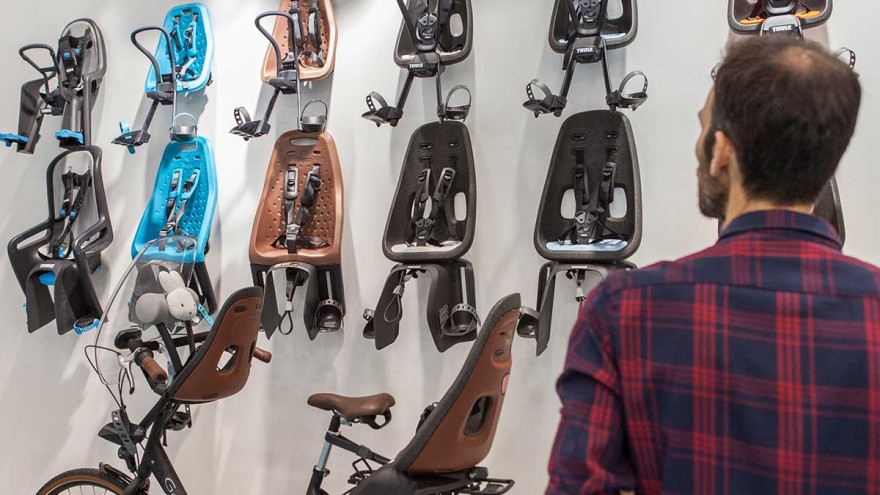Safe on a bike with kids in a seat or trailer
4 May 2021

Toting kids along on a bike means increased mobility for parents. ©Koelnmesse
Whether for everyday errands or family outings, more and more parents are getting on their bikes instead of in their cars. But what do you do with the little ones? Along with child bike seats, there are also more and more bike trailers out there. Only an expert retailer can give good advice about which solution is the right one for a family.
Toting kids along on a bike means increased mobility for parents. But first they have to be sure that their little ones will be safe, comfortable and well protected on the road. Needless to say, the transport solution should also be stable as well as easy to handle and not affect the ride performance. Child seats and bike trailers each have their own strengths and weaknesses so it is important to get expert advice.
This commitment pays off for retailers because the demand for bicycles and e-bikes has been increasing over the years. Between 2010 and 2018, sales in Germany climbed from EUR 2.4 billion to around EUR 4.5 billion. Right now, demand is through the roof due to the coronavirus pandemic, which is also driving the market for child transport accessories.
Child seats: uncomplicated for short distances
Do your customers use the bike more for short distances in everyday life? Then a child seat mounted to the back of the bike frame may be the right choice. Models such as the ergonomic Caress from Hamax or Bobike Go safety seat – both for children weighing up to 22 kg – are relatively inexpensive as well as quick and easy to attach. Many parents also enjoy the close proximity to their little ones on the bike – however, the child must be able to sit up unaided. Suitable child seats should comply with standard EN 14344. Parents also place particular importance on safety features such as harness belts, side panels, headrests and adjustable footrests with straps to keep kids from getting their toes caught in the spokes.
Disadvantages: The little passengers are not protected from rain and wind, and since they cannot change their sitting position, it can quickly become uncomfortable. Parents also cannot carry too much else on the bike and have to focus strongly on maintaining their balance while riding.

Child seats and bike trailers each have their own strengths and weaknesses so it is important to get expert advice. @Koelnmesse
Bicycle trailer: comfortable and safe on the road
Do your customers like to take longer trips? Then bike trailers like the Sportrex from Queridoo or Thule Chariot Cross are a good recommendation. Both trailers come in a two-passenger model and can be converted into a buggy in a few simple steps. Children up to a height of around 1.15 metres can sit comfortably, are protected from rain and wind, and can play or sleep during the ride. Special baby carriers even let infants in on the action.
However, high-quality, stable trailers with good safety belts are significantly more expensive as well as heavier and larger than child seats, and not every trailer fits every bike – this is where good advice comes in. Due to their width, bike trailers need plenty of space. Handling takes some getting used to, especially when braking and maneuvering. Ask parents how their bikes are equipped and how much weight they are allowed to pull. In order to navigate hills with a full trailer, the bike should have several gears with smooth shifting and good brakes. It is best to let parents do a test drive with a trailer or child seat before buying.
How safe are the solutions?
In general, a bicycle trailer is the safer option, especially with a safety flag for better visibility. The most common risk when transporting a child on a bike is having an accident while getting on or off. With child seats, the risk of injury is greater due to the height of the fall. This danger is significantly less with bicycle trailers and they usually do not tip over if mom or dad falls with the bike.
However, neither solution will provide adequate protection in the event of a serious collision with a vehicle. That is why it is imperative that children always wear a helmet and be strapped in, regardless of whether they are on a seat or in a trailer.
